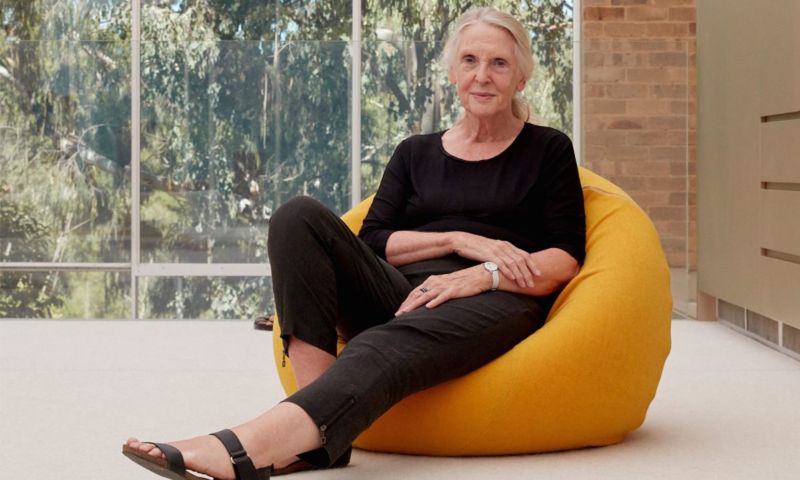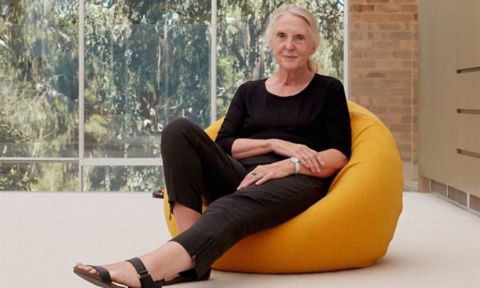Featherston said her interest in buildings and design developed as a child growing up in the United Kingdom and led to her study of interior design.
“As a design student at RMIT 60 years ago, I grappled with messy pre-computer tools, developed friendships and discovered Miles Davis in a dreary prefab building on the roof of the then Architecture Department,” she said.
“In these ironically ugly surroundings, a team of enthusiastic and knowledgeable lecturers encouraged us to explore the rich possibilities of design.”
All these years later and with the School of Architecture and Urban Design now based in the iconic Design Hub building, Featherston has returned to her alma mater to shape the next generation of designers.
“In 2019 RMIT celebrated 80 years of teaching interior design and I was delighted to be appointed an adjunct professor,” she said.
“So far I’ve participated in seminars and design studios and I’m looking forward to future collaborations with the University.”
Featherston has lobbied for socially responsible design, initially to create new community-based services and environments for young children and then schools for primary and secondary aged children.
Her successful 1982 campaign to establish Australia’s first children’s museum in the Museum of Victoria revolutionised how exhibitions are designed for children.
The convention of ‘look, don’t touch’ was replaced with a myriad of interactive elements that has become a staple of modern museums, such as Melbourne’s Scienceworks and Canberra’s Questacon.
Featherston’s other significant education projects include the Victorian Government-funded Inside Out Refurbishment Project at Dandenong’s Wooranna Park Primary School (2003–2009) and new types of learning spaces for the multi-award-winning Dandenong High School regeneration project (2007–2009) with Hayball Architects.
Featherston has fond memories of her time as an RMIT student in the 1960s.
“Some teachers were to have a life-long effect on my appreciation of design, one in particular who emphasised the social responsibility of design and the ways in which physical surroundings affect people’s lives,” she said.
“I vividly remember tours of housing commission concrete housing projects and revealing conversations with residents.”
Featherston supports the right for young children to have the best education can offer and the role of interior design in achieving this.
With over 50 years of design practice, she has collaborated with leading Australian and international educators, architects, school communities and policy makers to develop highly participatory design processes and innovative interior design.
“I have always been interested in the ways in which children interreact with their physical surroundings – they learn through all their senses, actively and socially,” she said.
“When I began pursuing this interest in schools, design of the physical environment was seen as an irrelevant luxury.
“But over the years, and especially recent findings from neuroscience, has demonstrated the crucial influence of our physical surroundings in shaping our feelings, memories and wellbeing.
“I continue to be intrigued by the rich possibilities of design to organise space and bring people together in particular ways.”
Her studies at RMIT also lead to one of the country’s most celebrated design partnerships between Grant and Mary Featherston, which innovated manufacturing techniques in the furniture industry and produced furniture that are now icons of Australian design.
Featherston met Grant while on an excursion, one of many where she met significant local designers in their workplaces.
Another life-long influence of Featherston’s was Robin Boyd, who she called one of Australia’s most influential architects.
“It was student visits to his bold but very liveable houses that emboldened my approach to the creation of interior spaces,” Featherston said.
“Robin, who had long championed Grant’s early experimental furniture design, became a friend, colleague, client and the architect of our home/studio.”
Coincidently, an RMIT Design Archives Journal issue on Robin Boyd is shortlisted for a Bates Smart Award for Architecture in Media in the 2020 Victorian Architecture Awards.
Associate Dean of Interior Design Suzie Attiwill said Featherston had already been involved as a guest critic and speaker in the School of Architecture and Urban Design and the Design Hub Gallery.
“Mary brings high level of expertise and track record to a growing research trajectory in the discipline of interior design addressing learning ecologies,” she said.
“Further to this, her background in exhibitions as interactive and knowledge production will inform new and innovative approaches to research outcomes that explore the synergy between exhibitions and learning environments.
“Central to her design philosophy is a commitment that design should be for all.”
The RMIT Design Archives is procuring Featherston’s design work in relation to learning and environments and education.
Story: Aeden Ratcliffe





